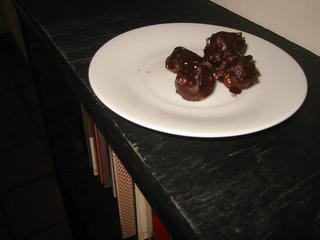
I've been thinking about cake this week. I watched a special on the Food Network about the founder of Cake Love, a bakery in Washington D.C. that my friend Mara introduced me to on my last visit. The owner dropped his law career to create a bakery, one that places more emphasis on taste than looks-- in some of the cakes, the filling is bursting out of its lovable and misshapen contours. But who cares? The desserts are delicious. And there's the name -- Cake Love-- which sounds like some sort of supportive, hippie religion dedicated to the worship of baked goods. I went there more than once on my last visit to DC to sample cupcakes and other delights. When I go back this December for an academic conference, Cake Love will definitely be on my list of places to go, along with Ben's Chili Shop, Lebanese Taverna, and Bistrot du Coin in DuPont Circle...
Although I have a wonderful family recipe for pound cake that is called "Crust Cake," which develops a sweet and crunchy crust, it is somewhat heavy and therefore the kind of thing I only like to make once a year or so. This recipe is a little lighter, brighter, and less heavy. It's from the magazine Cook's Illustrated, which I love for their thorough testing of recipes in search of perfection. I knew this would be a winner, and it was-- sweet yet tart, moist yet not gummy, delicate yet substantial. I will definitely make this again.
Lemon Pound Cake
2 sticks butter
1 1/2 cups cake flour
1 tsp. baking powder
1/2 tsp. salt
1 1/4 cups sugar
2 Tblsp. grated lemon zest plus 2 tsp. lemon juice
4 large eggs
1 1/2 tsp. vanilla extract
Lemon Glaze
1/3 cup sugar
1/4 cup lemon juice
Preheat oven to 350. Grease a 9 by 5 loaf pan with 1 Tblsp. softened butter, dust with 1 Tblsp. flour and tap out excess.
In medium bowl, mix flour, baking powder, and salt, set aside.
Melt the butter on the stove and stir it up to make sure it's mixed. In a food processor, process sugar and zest until combined. Add lemon juice, eggs, and vanilla until combined. Keep machine running and add melted butter, remove mixture to large bowl. Sift flour mixture over eggs in three batches, mixing just to combine after each step. Pour into breadloaf pan and bake 15 minutes. Reduce oven temperature to 325 and bake until golden brown, about 35 minutes more. When toothpick comes out clean, it's ready. Check after 35 minutes, but I found mine took another 5-7 minutes longer. Cool for 10 minutes, turn out onto wire rack, brush Lemon Glaze onto top and sides with a pastry brush.
Lemon glaze: bring sugar and lemon juice to boil, stirring until sugar dissolves. Reduce heat to low, simmer 2 minutes until thick.







